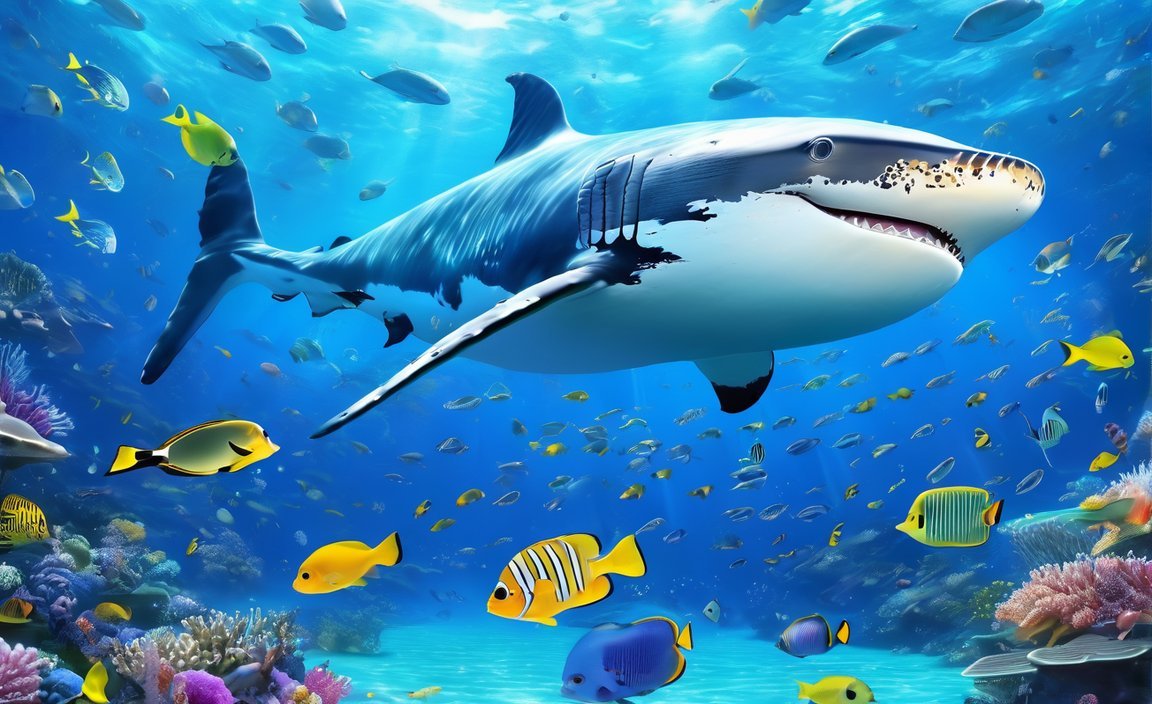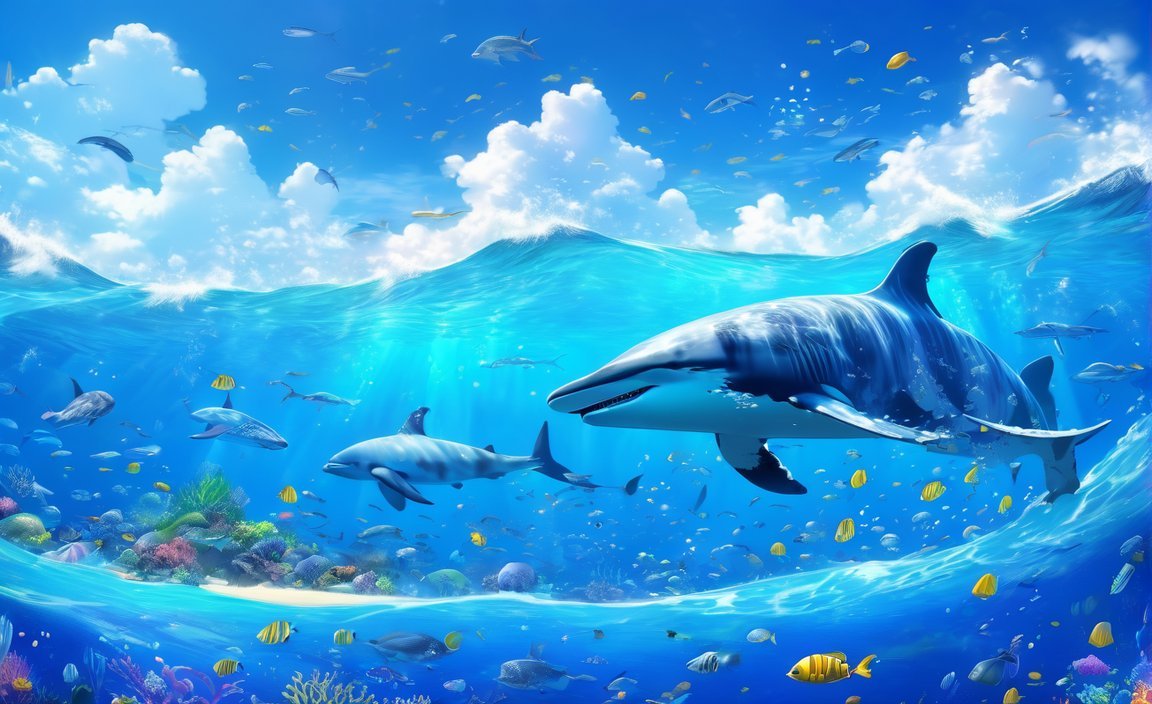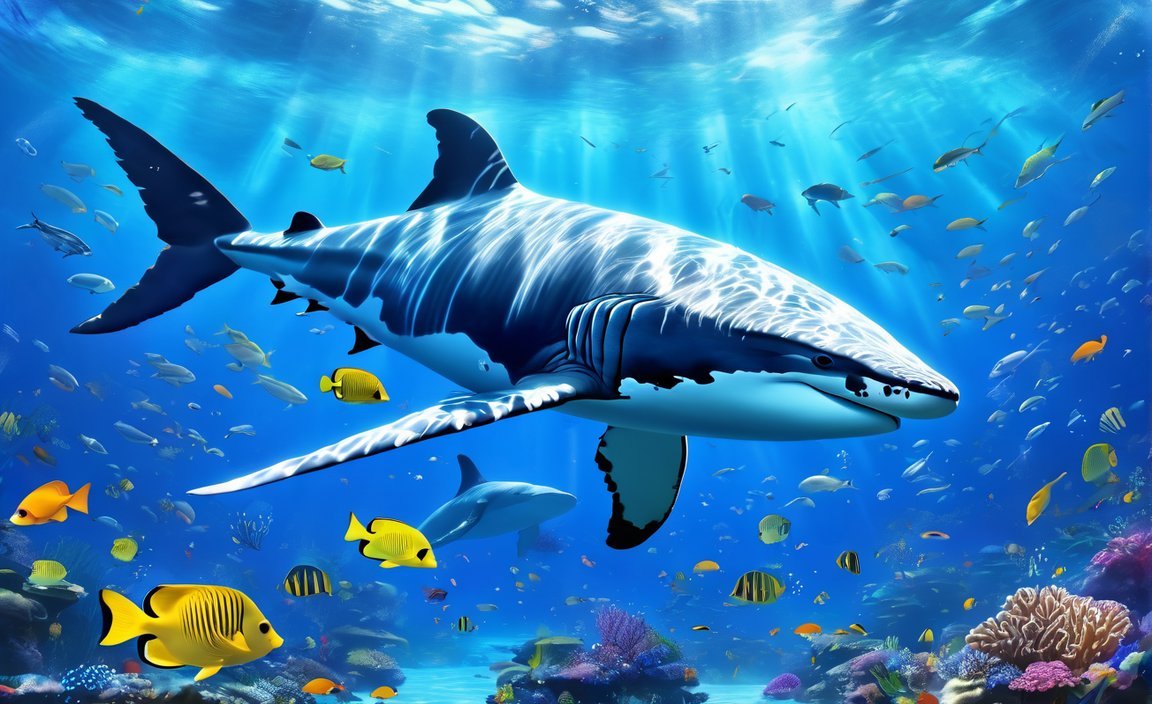Welcome to the mesmerizing world of oceanic wonders! In this article, we will be diving into the depths of the ocean, uncovering an array of incredible animal facts that are sure to leave you in awe. From the enchanting behavior of dolphins to the astonishing adaptations of deep-sea creatures, get ready to be captivated by the amazing secrets of the ocean. So, tighten your diving gear and prepare to be amazed as we embark on a journey of [Diving into the Depths: Unearthing Amazing Ocean Animal Facts]. Let’s begin our exploration of the astounding wonders that await beneath the waves.
Key Takeaways:
- Seahorses are unique in that the male, not the female, gives birth and cares for their young.
- Shrimp have their heart located in their head.
- Sea sponges are living organisms despite lacking various body parts like a head, mouth, and brain.
- Turtles can be found on every continent except Antarctica.
- The world’s oceans are believed to house up to 1 million species, with the majority still undescribed.
- The giant crab of Japan can reach sizes as large as 12 feet across.
- Sharks possess the ability to detect minute traces of blood in vast amounts of water.
- There are over 230,000 known species of sea animals, covering fish, mammals, birds, reptiles, and invertebrates.
- The ocean is home to the largest animal on Earth, the blue whale, which can grow up to 100 feet long and weigh over 200 tons.
- Sponges, despite lacking various body parts, are still classified as living organisms.
- Jellyfish have a longer existence than dinosaurs, making them one of the oldest animals.
- There are two major types of seals: “eared seals” with external ears like sea lions and fur seals, and “true seals” without external ears.
- The massive oil-filled head of sperm whales helps prevent them from experiencing decompression sickness.
- The elephant seal holds the title for being the largest “true seal.”
Amazing Ocean Animal Facts

The depths of the ocean hold a multitude of secrets, and the incredible creatures that inhabit these waters never cease to amaze us. In this article, we will dive into the mesmerizing world of ocean animals and uncover some truly astonishing facts that will leave you in awe.
1. Seahorses: Dads Know Best
Let’s start with seahorses, these fascinating creatures have a remarkable twist when it comes to parenting. Unlike most animals, it is the male seahorse who carries and gives birth to their young. Yes, you read that right! The male seahorse has a pouch where the female deposits her eggs, and he takes on the responsibility of nurturing the growing embryos until they’re ready to be released into the world. Talk about fatherly devotion!
2. Shrimp: A Heart in the Head
Did you know that a shrimp’s heart is located in its head? It may seem hard to believe, but these little crustaceans boast a unique anatomical feature that sets them apart from other heart placements. You see, a shrimp’s heart is nestled just above its mouth, pumping away inside its tiny head. A true testament to nature’s extraordinary adaptations!
3. Sea Sponges: Living Mysteries
Sea sponges may seem deceptively simple, lacking many of the organs we associate with living creatures. However, these seemingly mundane organisms are, indeed, alive! They don’t possess a head, mouth, eyes, feelers, bones, heart, lungs, or brain, and yet, they thrive in the ocean’s vast expanses. Their survival depends on remarkable processes conducted at the cellular level, reminding us that life can take on countless forms.
4. Turtles: A Global Presence
Turtles are magnificent creatures that have managed to establish their presence on nearly every continent. However, you won’t find them waddling across Antarctica’s frozen landscapes. From the coasts of Australia to the rivers of North America, turtles have conquered a wide range of environments, showcasing their adaptability and resilience.
5. A World of Wonder
The world’s oceans are teeming with an astonishing array of life. It is estimated that there may be up to 1 million species residing in these underwater realms, with a staggering two-thirds of them yet to be described! Just imagine the incredible diversity that awaits our discovery beneath the waves, hinting at countless mysteries waiting to be unraveled.
6. Giants of the Deep: The Japanese Giant Crab
Prepare to be amazed by the size of the Japanese Giant Crab. This colossal crustacean can reach lengths of up to 12 feet across, making it a true behemoth of the ocean. As you envision this giant crab scuttling across the seafloor, you can’t help but marvel at the wonders of nature’s grand design.
7. Sharks: Bloodhounds of the Sea
Sharks possess an astonishing ability to detect an infinitesimal amount of blood in the vastness of the ocean. Their highly developed sense of smell enables them to detect one part of blood in 100 million parts of water. This remarkable sensory adaptation allows sharks to navigate their environment with unrivaled precision, making them marine super sleuths.
8. Diverse Marine Life
The ocean is a haven for more than 230,000 known species of animals, ranging from fish and mammals to birds, reptiles, and invertebrates. From the vibrant coral reefs teeming with exotic fish, to the majestic whales gracefully gliding through the open waters, every nook and crevice of the ocean holds a surprising abundance of life. It’s a mesmerizing world waiting to be explored.
9. The Blue Whale: A Colossus of the Deep
Behold the largest creature to have ever graced our planet, the magnificent blue whale. These gentle giants can grow up to 100 feet long and weigh over 200 tons. Just imagine the awe-inspiring sight of this colossal mammal as it majestically swims through the sapphire waters. The blue whale’s immense size is a testament to the sheer grandeur of the ocean and its inhabitants.
10. Jellies: Ancient Survivors
Jellyfish, with their ethereal appearance, have roamed the ocean for far longer than dinosaurs roamed the land. These otherworldly creatures are one of the oldest animals on Earth, their existence predating even the mighty dinosaurs. It’s as if they’ve mastered the art of defying time, captivating us with their graceful movements and delicate beauty.
11. Seals: Different Ears, Different Seals
Seals, known for their playful nature, come in two major types: “eared seals” and “true seals.” Eared seals, such as sea lions and fur seals, are easily distinguishable by their external ears. On the other hand, true seals lack external ears but make up for it with their adorable charm and inquisitive nature. These captivating creatures have enchanted both land and sea with their endearing antics.
12. Whales: Deep Diving Experts
Diving into the depths of the ocean can be an incredible feat, especially for whales. The sperm whale, with its massive oil-filled head, possesses a unique adaptation that prevents it from experiencing “the bends” after deep water dives. This physiological marvel allows these deep-diving giants to explore the ocean’s depths without suffering the potentially fatal consequences of nitrogen bubbles forming in their blood.
13. Elephant Seals: Kings of the Sea
The mighty elephant seal is the largest true seal, and its name is a testament to its colossal size. These magnificent creatures can grow to be as long as 20 feet and weigh over 8,000 pounds. Just envisioning them ruling their beachfront territories elicits a sense of awe and respect for their commanding presence.
As we’ve explored these amazing ocean animal facts, we hope to have ignited your curiosity and appreciation for the wonders that lie beneath the ocean’s surface. Let’s celebrate the diversity and uniqueness of these magnificent creatures and work together to protect their precious habitats. Remember, Earth’s oceans are our shared responsibility, and safeguarding them ensures the legacy of these awe-inspiring animals for generations to come.
Sources:
Ocean Animals Facts: 10 Amazing Things About Ocean Creatures – Source 1
FACTS ABOUT SEA ANIMALS – Remember Animals – Source 2
Here are some amazing and fascinating facts about ocean animals. Prepare to be amazed by the incredible diversity and unique adaptations of these creatures! You can learn more about these amazing facts about ocean animals here: amazing facts about ocean animals
Did you know that sea animals have their own set of mind-blowing facts? From fascinating behaviors to incredible survival strategies, sea animals are truly astonishing. Dive deeper into the world of sea animals and discover more amazing facts here: amazing facts about sea animals
Explore the depths of the ocean and uncover the hidden wonders of sea creatures. From mesmerizing abilities to stunning physical features, these creatures will leave you in awe. Learn more about the amazing facts about sea creatures here: amazing facts about sea creatures
Experience the enchanting world of sea life with its astonishing variety and beauty. Discover mind-blowing facts about these captivating creatures and their intricate ecosystems. Immerse yourself in the wonders of sea life here: amazing sea life facts
Curious about the laws regarding the alligator snapping turtle in Texas? Find out more about the regulations and requirements governing these amazing creatures here: alligator snapping turtle Texas laws
Are you interested in animal-assisted therapy activities? Discover the incredible impact animals can have on mental health and well-being. Explore a wide range of enriching activities and learn more here: animal-assisted therapy activities
The Astonishing Anatomy of the Anglerfish and Its Captivating Mating Behavior

Deep-sea anglerfish are intriguing creatures that inhabit the dark depths of the ocean. Known for their unique adaptations and fascinating features, they have captured the attention of scientists and ocean enthusiasts alike. Let’s delve into the astonishing anatomy of the anglerfish and explore their captivating mating behavior.
Huge Head, Vast Mouth, and Flattened Body
All anglerfish possess a distinct physical appearance. They have a large head, a gaping mouth, and a flattened body. These features are adaptations that enable them to effectively catch prey. However, not all anglerfish look the same. For example, deep-sea anglerfish that dwell close to the seabed have a flattened dorso-ventral body shape, similar to a plate on a table, with their mouths facing upwards. This unique morphology allows them to capture prey more efficiently in the challenging deep-sea environment[^1].
Carnivorous Nature and Specialized Feeding Techniques
Anglerfish are carnivorous creatures, and their adaptations primarily aid them in catching prey. Deep-sea anglerfish face the challenge of irregular prey encounters in their habitat. To ensure successful feeding, they have developed large mouths and stomachs, as well as long, sharp teeth. These adaptations enable them to capture and swallow anything that comes their way[^3]. In addition, some anglerfish species possess specialized light-producing organs called photophores. These bioluminescent features help them attract prey or communicate with other anglerfish in their dark environment[^6].
The Anglerfish’s Lure and Impressive Adaptations
One of the most iconic features of anglerfish is the modified first spine of their dorsal fin, which acts as a “fishing rod” with a fleshy bait attached to it. Prey fish are attracted to this bait, becoming unsuspecting victims of the anglerfish’s predatory tactics[^4]. Anglerfish also have impressive size variations, with some measuring as little as 8 inches and others reaching up to a whopping 40 inches. The largest specimens can even weigh up to 110 pounds[^2]. These fascinating creatures are found in deep, dark ocean habitats, and their unique adaptations allow them to survive in the extreme pressure and frigid temperatures of the deep-sea environment[^3].
Captivating Mating Behavior
The mating behavior of anglerfish is truly captivating. In many anglerfish species, the males are significantly smaller than the females and have a unique strategy for reproduction. The male anglerfish, once it reaches sexual maturity, will search for a female by using its highly developed sense of smell. Once he finds a female, he latches onto her using his specialized teeth. Over time, the male’s body will fuse with the female’s body, and he will essentially become a parasitic appendage, providing sperm for the female’s eggs whenever she is ready to reproduce[^4]. This phenomenon, known as sexual parasitism, is truly astonishing and exemplifies the incredible adaptability and diversity found in the animal kingdom.
Key Takeaways:
- Deep-sea anglerfish possess a unique physical appearance, including a large head, gaping mouth, and flattened body.
- They are carnivorous creatures with specialized feeding techniques, such as large mouths, stomachs, and sharp teeth.
- Anglerfish have a modified first spine of their dorsal fin that acts as a “fishing rod” with a fleshy bait attached, attracting prey fish.
- Some species of anglerfish exhibit remarkable bioluminescent features through specialized light-producing organs called photophores.
- Male anglerfish have a fascinating mating behavior known as sexual parasitism, where they become fused with the female’s body to provide sperm for reproduction.
References:
[^1]: Fact Animal. Anglerfish
[^2]: National Geographic. Anglerfish | National Geographic
[^3]: Oceana. Deep Sea Anglerfish – Oceana
[^4]: Britannica. Anglerfish
The Unbelievable Speed and Agility of the Sailfish, the Fastest Fish in the Ocean
Deep in the vast expanse of the ocean, a creature roams with unmatched speed and agility. With its sleek body and powerful fins, the sailfish propels itself through the water at incredible speeds, making it the fastest fish in the ocean. In this article, we will dive into the world of the sailfish, uncovering the secrets behind its astonishing speed and agility.
The Speed Demon of the Ocean
At speeds of up to 70 miles per hour (112 kilometers per hour), the sailfish dominates the underwater realm with its unmatched velocity. Its streamlined body, designed for aerodynamic efficiency, glides effortlessly through the water, leaving other marine creatures in awe. The sailfish’s ability to reach such incredible speeds is attributed to its long, slender body and a large dorsal fin that resembles a sail.
Agile Hunter and Fearless Swimmer
The sailfish’s speed is not the only remarkable aspect of its prowess. This magnificent creature is also known for its exceptional agility. With lightning-fast reflexes, the sailfish effortlessly maneuvers through the water, making it a formidable hunter. Its schooling behavior, often seen in groups of up to 50 fish, allows for cooperative hunting strategies and further enhances its hunting success.
Habitat and Distribution
The sailfish can be found in tropical and temperate waters around the world. Its global presence highlights its adaptability to various climates and oceanic conditions. From the warm waters of the Caribbean to the cooler depths of the Pacific, the sailfish thrives in diverse environments, showcasing its remarkable ability to navigate through different habitats.
A Game Fish and Conservation
Although the sailfish’s speed and agility make it a captivating creature, it is not widely consumed due to its tough meat. However, it holds great significance in the world of sport fishing. Anglers from around the globe are lured by the thrill of catching this fast and elusive fish, making it a prized catch in the fishing community.
Despite being highly sought after for sport fishing, the sailfish is not currently listed as an endangered species. However, it is essential to increase awareness about the importance of ocean conservation and the protection of all marine creatures, including the remarkable sailfish.
Key Takeaways:
- The sailfish is the fastest fish in the ocean, capable of swimming at speeds of up to 70mph (112 kph).
- Its long, slender body and large dorsal fin are the key anatomical features that enable its high-speed swimming.
- Sailfish often travel in groups called schools, which can consist of up to 50 individuals.
- They can be found in tropical and temperate waters worldwide, showcasing their adaptability.
- Sailfish are highly valued as game fish, but their tough meat makes them less suitable for consumption.
- While not currently endangered, it is crucial to promote ocean conservation to protect the sailfish and its fellow marine inhabitants.
Cited Sources:
Ocean Info – Sailfish – The Fastest Fish in the Ocean
National Geographic – Sailfish
The Mesmerizing Bioluminescence of Deep-Sea Creatures and Their Adaptations for Survival
Deep beneath the ocean’s surface lies a captivating world filled with extraordinary creatures that have evolved unique adaptations to thrive in the darkness of the deep sea. Among these adaptations, bioluminescence stands out as a mesmerizing phenomenon that illuminates this mysterious realm. In this article, we will delve into the enchanting bioluminescence of deep-sea creatures and explore how this adaptation aids their survival.
Bioluminescence: A Dazzling Display of Survival
Bioluminescence refers to the ability of organisms to produce light through a chemical reaction within their bodies. This remarkable adaptation is prevalent in deep-sea organisms, where darkness prevails and sunlight cannot penetrate. It serves a multitude of purposes, including communication, camouflage, attracting prey, and finding mates.
The Enchanting World of Deep-Sea Jellyfish
One fascinating example of bioluminescence in deep-sea organisms is found in jellyfish, particularly the Atolla wyvilleias species. When under attack, these jellyfish release a burst of light, acting as a “burglar alarm” to attract larger predators. This clever tactic allows them to escape from their initial attacker unharmed and demonstrates how bioluminescence aids in survival by deterring predators.
Shining a Light on Deep-Sea Adaptations
Deep-sea creatures face numerous challenges, including high water pressure and low light levels. To overcome these hurdles, they have developed remarkable adaptations that rely on bioluminescence.
Vampire Squid: Master of Disguise
The vampire squid, with its bioluminescent abilities, has an extraordinary method of defense. When threatened, it releases a cloud of glowing fluid, diverting the attention of predators and allowing it to escape. This unique adaptation not only helps the vampire squid evade predation but also leaves its predators vulnerable to potential prey.
Communication in the Dark: The Language of Light
In the deep-sea environment, where visibility is limited, many organisms use bioluminescence to communicate with each other. They emit flashes of light, creating a visual language that allows them to convey messages, attract potential mates, and coordinate group activities. This intricate communication system plays a crucial role in their survival and reproduction.
Diving into the Depths: Exploring the Wonders of Bioluminescence
Bioluminescence is not exclusive to the deep sea but is most commonly observed in these remarkable organisms that inhabit its depths. The light produced by bioluminescent organisms can vary in color, ranging from luminous blues and greens to vivid purples and sometimes even red. It illuminates the dark abyss, offering a captivating view into the secret lives of these creatures.
Key Takeaways:
- Bioluminescence is a fascinating adaptation that allows organisms to produce light in the deep sea.
- Deep-sea creatures utilize bioluminescence for various purposes, including defense, communication, attracting prey, and finding mates.
- Jellyfish like Atolla wyvilleias use bioluminescence as a “burglar alarm,” attracting larger predators to attack their attacker.
- The vampire squid releases a cloud of glowing fluid instead of ink to distract predators while escaping.
- Bioluminescence plays a crucial role in the survival of deep-sea organisms, allowing them to navigate, communicate, and defend themselves effectively in their challenging environment.
Sources:
– NOAA Ocean Exploration: Investigation: Bioluminescence – An Adaptation for Deep-sea Survival
– Smithsonian Ocean: Bioluminescence
FAQ
Q1: What is the most fascinating fact about deep-sea anglerfish?
A1: Deep-sea anglerfish possess a modified first spine of their dorsal fin that acts as a “fishing rod” with a fleshy bait attached to it, attracting prey fish and making them unsuspecting victims of the anglerfish’s predatory tactics.
Q2: How do deep-sea anglerfish survive in their extreme habitat?
A2: Deep-sea anglerfish have unique adaptations that allow them to thrive in the harsh conditions of the deep ocean, such as a flattened dorso-ventral body shape that helps them capture prey efficiently and specialized bioluminescent features that aid in attracting prey and communication in the dark environment.
Q3: What makes sailfish the fastest fish in the ocean?
A3: Sailfish are known for their long, slender bodies and large dorsal fins, which allow them to swim at speeds of up to 70mph (112 kph), making them the fastest fish in the ocean.
Q4: What is the role of bioluminescence in deep-sea survival?
A4: Bioluminescence plays a crucial role in deep-sea survival by aiding organisms in navigation, communication, and defense. It helps organisms attract prey, find mates, and deter or distract predators, increasing their chances of survival in the extreme conditions of the deep sea.
Q5: Are there any surface-dwelling organisms that exhibit bioluminescence?
A5: While bioluminescence is most commonly observed in deep-sea organisms, some surface-dwelling organisms also exhibit this phenomenon. It occurs through chemical reactions in living organisms, resulting in the production of light, which aids in communication, camouflage, and other survival strategies.
- Unveiling Bernhard Caesar Einstein’s Scientific Achievements: A Legacy in Engineering - July 15, 2025
- Uncover who is Jerry McSorley: CEO, Family Man, Business Success Story - July 15, 2025
- Discover Bernhard Caesar Einstein’s Scientific Contributions: Unveiling a Legacy Beyond Einstein - July 15, 2025















